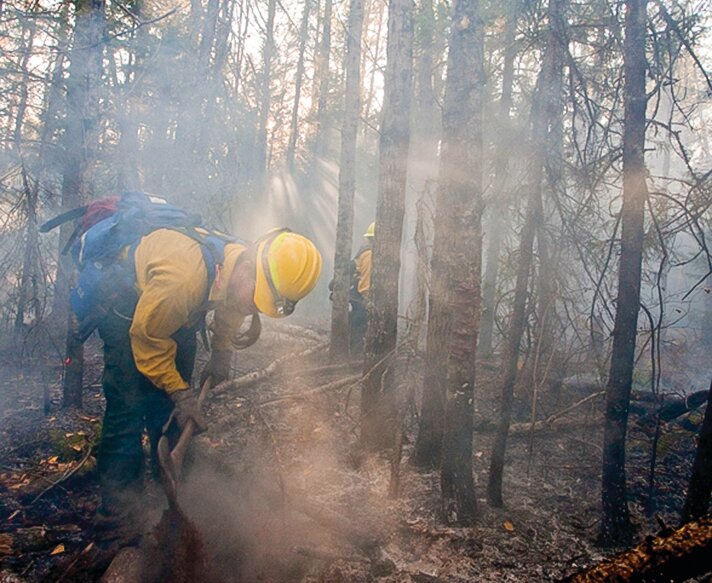Support the Timberjay by making a donation.
Forest service plans 7,000 acres of burning
Spring prescribed fire season largely weather-dependent
REGIONAL— If you see or smell smoke in the North Country this spring, don’t be surprised. Fire crews on the Superior National Forest fire have begun their spring prescribed fire season …
This item is available in full to subscribers.
Attention subscribers
To continue reading, you will need to either log in to your subscriber account, below, or purchase a new subscription.
Please log in to continue |
Forest service plans 7,000 acres of burning
Spring prescribed fire season largely weather-dependent
REGIONAL— If you see or smell smoke in the North Country this spring, don’t be surprised. Fire crews on the Superior National Forest fire have begun their spring prescribed fire season and, weather permitting, they hope to burn just over 7,000 acres over the next several weeks within the two million acres of the national forest located outside the Boundary Waters Canoe Area Wilderness (prescribed burns in the BWCAW are planned separately).
Prescribed burning often has a narrow window of opportunity, as it is usually conducted in the spring and fall before green up and after green vegetation has died off, when vegetation is more combustible.
While the forest has prescribed fire plans developed to burn up 7,059 acres, burning all planned acres depends on many factors such as weather and vegetation conditions, fire staff availability, and other considerations. Early spring drought has also reduced prescribed burning opportunities.
Why use prescribed burning?
Prescribed fires help reduce hazardous fuel build-up and the risk of intense wildfire. In addition, they improve and maintain forest health and wildlife habitat and eliminate invasive species. The meadow and forest ecosystems in northeastern Minnesota are fire-dependent and rely on periodic fires to stay healthy. Prescribed fire also is culturally significant to indigenous people of this area.
Planning for fire
Prescribed fire plans are proposed and approved through environmental analysis, often in conjunction with timber harvest operations and environmental review documents are available on the Superior National Forest’s website’s projects page, found at www.fs.usda.gov/projects/superior/landmanagement/projects.
Burn plans for each unit define critical safety factors, weather conditions, air quality standards, personnel availability and environmental regulations that must be met. These are continually monitored before the burn proceeds to determine feasibility of moving forward with the prescribed burn, during and after the burn.
“We were able to do a select few prescribed burns for oak blueberry habitat improvement last month, and now are waiting until conditions improve to do the meadow burns and other burn treatments such as under-burning and broadcast burning. Under-burning is low-intensity and targets the forest floor vegetation like brush and small trees. Broadcast burning is a more moderate burning technique applying fire to specific areas to meet desired conditions for forest health objectives. We’d like to use all these options for prescribed burning for specific units to reduce excess fuel build-up,” said Nick Petrack, the Superior and Chippewa national forests’ fire management officer.
Types of prescribed fire projects include:
• Under-burning is a low intensity fire that burns beneath the canopy of live trees. The understory materials that would be consumed include small down, dead, woody material and live forbs, shrubs and seedlings. Some live mature trees may be burned, but the intent is to maintain the forest canopy.
• Broadcast burning is a prescribed burning activity where fire is applied generally to most or all of an area within well-defined boundaries for reduction of fuel hazard, as a resource management treatment; or both burn intensity varies throughout the treatment unit depending on vegetation, fuels, and topography. These burns create a new stand at the young age class. However, unburned areas or lightly burned areas within the unit may be common.
• Site preparation burn is a broadcast burn applied across a harvest unit. Harvest slash is consumed to reduce fuel hazards to acceptable levels, while duff and brush competition is reduced to acceptable levels to promote successful regeneration.
• Pile burns are burn piles of operator slash after harvest or piles as a result of hand piling.
• Mosaic burns are done where burn intensity varies throughout the treatment unit depending on vegetation, fuels, and topography, creating a mosaic pattern in the unit.
During active burning, smoke and flames may be visible from roads and areas near the burn unit. Smoke may settle in low areas in the evening hours.
Affected individuals will be notified of prescribed fires that are conducted on national forest system lands in their vicinity the day of the burn.






